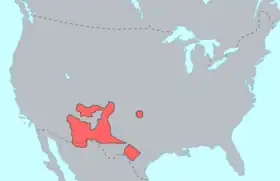Lenguas apacheanas
Las lenguas apacheanas son un grupo de la rama de lenguas atabascanas de la familia lingüística na-dené. También se conocen con el nombre de lenguas atabascanas meridionales. El grupo se subdivide en tres ramas: apache-kiowa y apacheanas occidentales y apacheanas orientales.
| Lenguas apacheanas | ||
|---|---|---|
| Hablado en |
| |
| Región | Sonora, Chihuahua, Coahuila, Grandes Llanuras | |
| Hablantes | 6000 | |
| Familia |
Na-Dené | |
| Estatus oficial | ||
| Regulado por |
Instituto Nacional de Lenguas Indígenas ( | |
| Códigos | ||
| ISO 639-2 | apa | |
 | ||
Las lenguas apaches son habladas por casi 6000 hablantes en los estados norteamericanos de Arizona, Nuevo México, Oklahoma y en los estados mexicanos de Chihuahua, Sonora y Coahuila.[1]
Clasificación
Las lenguas apaches o apacheanas constituyen la rama meridional de la familia atabasca y representan una migración relativamente reciente desde el Noroeste de América del Norte. Estas lenguas se dividen en tres grupos principales:
I. Apache de las praderas
II. Lenguas apacheanas occidentales
- A. Mescalero-chiricahua
- 2. Idioma chiricahua (N'nee biyat'i)
- 3. Idioma mescalero (Ndé biiza')
- 4. Idioma navajo (Diné bizaad)
- 5. Idioma apache coyotero (N'dee biyat'i)
III. Lenguas apacheanas orientales
- 6. Idioma jicarilla (Abaachi miizaa)
- 7. Idioma lipán (Ndé miizaa)
Comparación léxica
Los numerales en diferentes lenguas apacheanas son:[2][3]
GLOSA Apache
occid.Navajo Mescalero Chiricahua
(San Carlos)Jicarilla PROTO-
APACHEANO'1' dáłaʼá
dáłaʼétʼɑ́aɑ łɑ́ʼí tašayay datła
dišłaitahčli *táłaʼáí '2' nɑ́kih nɑːki nahki nɑːki nahki *náˑʔki '3' tɑ̄ːgi tɑ́ːʼ kayai tɑːgi
kɑːgekiyi *táˑʔgi '4' dɪ̨̄ːʼi dɪ̨́ːʼ inyeh dingi tini *dɪ́ˑŋgi '5' ɑšdlaʼi
išdlaʼiɑšdlɑʼ aštlai aštla
ištliatsčli *ašdlaʼi '6' gostɑ́n hɑstɑ̜́ː hostkonnai goːstan koskon *gostáˑn '7' gostsʼidi
gostsʼigitsotsʼid hosteedai gastede kossetpi *gostsʼidi '8' tsebīː
sebīːtseːbíː hahpi tsepi tsapi *tsáˑʔpi '9' góstʼɑ́í
ńgóstʼɑ́ínɑ́hɑ́stʼéí 'nghostai 'ngostai nusti *ngostʼáí '10' goneznɑ́n
goniinɑ́nneːznɑ́ː gonaihannai koneznan *goneˑznáˑn
Referencias
- «Historia de la lengua y cultura n’dee/n’nee/ndé».
- V. Dosch Hymes, 1955, pp. 26-45.
- «Na-Dené Numerals». Archivado desde el original el 11 de mayo de 2011. Consultado el 13 de mayo de 2012.
Bibliografía
- Dosch Hymes, Virginia: "Athapaskan Numeral Systems", International Journal of American Linguistics, Vol. 21, No. 1, pp. 26-45, 1955.
- Hoijer, Harry. (1938). The southern Athapaskan languages. American Anthropologist, 40 (1), 75-87.
- Hoijer, Harry. (1945). Classificatory verb stems in the Apachean languages. International Journal of American Linguistics, 11 (1), 13-23.
- Hoijer, Harry. (1945). The Apachean verb, part I: Verb structure and pronominal prefixes. International Journal of American Linguistics, 11 (4), 193-203.
- Hoijer, Harry. (1946). The Apachean verb, part II: The prefixes for mode and tense. International Journal of American Linguistics, 12 (1), 1-13.
- Hoijer, Harry. (1946). The Apachean verb, part III: The classifiers. International Journal of American Linguistics, 12 (2), 51-59.
- Hoijer, Harry. (1948). The Apachean verb, part IV: Major form classes. International Journal of American Linguistics, 14 (4), 247–259.
- Hoijer, Harry. (1949). The Apachean verb, part V: The theme and prefix complex. International Journal of American Linguistics, 15 (1), 12–22.
- Hoijer, Harry. (1956). The Chronology of the Athapaskan languages. International Journal of American Linguistics, 22 (4), 219-232.
- Hoijer, Harry. (1963). The Athapaskan languages. In H. Hoijer (Ed.), Studies in the Athapaskan languages (pp. 1–29). University of California publications in linguistics 29. Berkeley: University of California Press.
- Hoijer, Harry (Ed.). (1963). Studies in the Athapaskan languages. University of California publications in linguistics 29. Berkeley: University of California Press.
- Hoijer, Harry. (1971). The position of the Apachean languages in the Athapaskan stock. In K. H. Basso & M. E. Opler (Eds.), Apachean culture history and ethnology (pp. 3–6). Anthropological papers of the University of Arizona (No. 21). Tucson: University of Arizona Press.
- Hymes, Dell H. (1957). A note on Athapaskan glottochronology. International Journal of American Linguistics, 22 (4), 291-297.
- Liebe-Harkot, Marie-Louise. (1984). A comparison of Apachean languages, exemplified by the verb system for handling verbs. In H. Krenn, J. Niemeyer, & U. Eberhardt (Eds.), Sprache und Text: Akten des 18: Linguistischen Kolloquiums, Linz 1983. Linguistische Arbeiten (Max Niemeyer Verlag) (Nos. 145-146). Tübingen: Max Niemeyer Verlag. ISBN 3-484-30145-7 (Bd. 1); ISBN 3-484-30146-5 (Bd. 2).
- de Reuse, Willem J. (2001). Prototypes and fuzziness in the system and usage of Apachean classificatory verb stems. In S. Tuttle & G. Holton (Eds.), Proceedings of the 2001 Athabaskan Languages Conference (No. 1, pp. 75–94). Fairbanks, AK: Alaska Native Language Center.
- Sapir, Edward. (1936). Linguistic evidence suggestive of the northern origin of the Navaho. American Anthropologist, 38 (2), 224-235.
- Young, Robert W. (1983). Apachean languages. In A. Ortiz, W. C. Sturtevant (Eds.), Handbook of North American Indians: Southwest (Vol. 10, pp. 393–400). Washington: Smithsonian Institution. ISBN 0-16-004579-7.